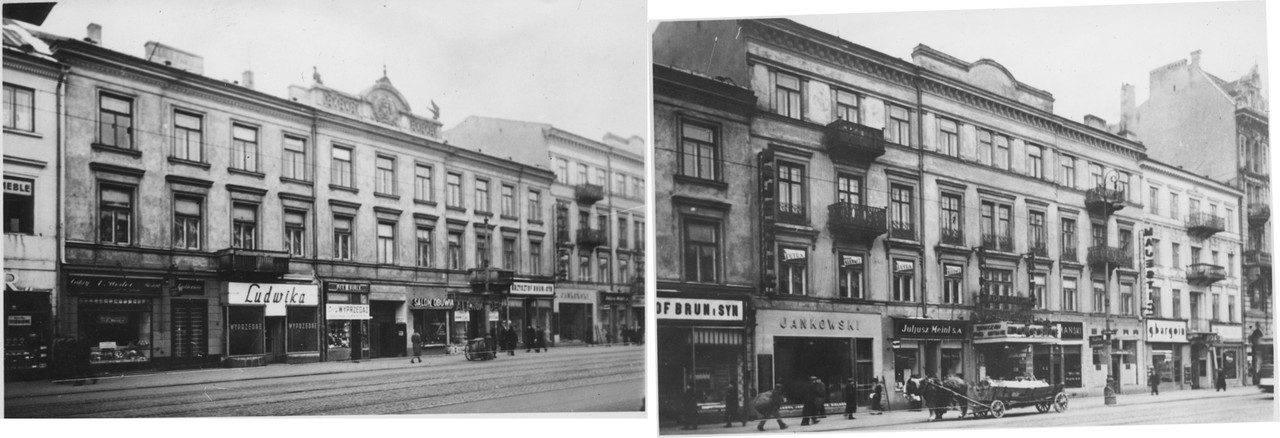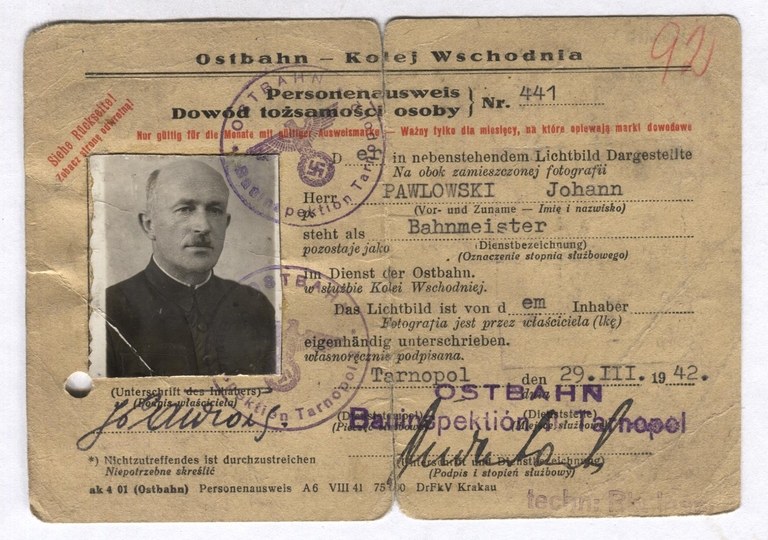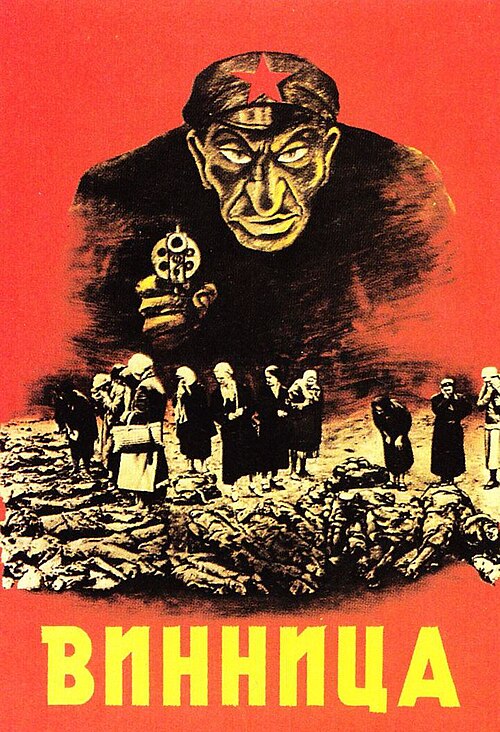Stubble wrote: ↑Mon Sep 29, 2025 1:22 pm
Image size on the forum natively is limited to something like 380kb. I use postimage.org. You upload the image and then select 'direct link' and it will host it for you.
I had some trouble uploading an image to the forum that was smaller than the size. Just showed a yellow warning sign, so I posted to postimage.org, based on Stubble earlier recommending it.
Regarding Franciszek Zabecki, I'm trying to find his book
Wspomnienia dawne i nowe and unable to find a digital version. If anyone tracks it down, a link would be appreciated. I found a park named after him, though

In case anyone else can benefit from these. I OCRed them, then went word by word fixing them. Could still be errors, of course.
TYDZIEŃ: PISMO INFORMACYJNE KONWENTU ORG. NIEPODLEGŁOŚCIOWYCH. 4 September 1943.
Link - Earliest reference to the revolt (so far)
Transcription
Podpalenie Treblinki- W Treblince nr 2 poza oddziałem SS i Ukraińców (160 ludzi) była specjalna grupa pomocnicza żydowska w liczbie 600, która pomagała przy traceniu Żydów. Dnia 3.VIII grupa ta napadła na straż, rozbroiła ją, zdobyła magazyn broni, podpaliła budynki i przebiła się do lasu, W czasie w alki ok, 200 Żydów zginęło. Niemców i Ukraińców raniono, względnie zabito około 50.
Translation
The Arson of Treblinka - In Treblinka No. 2, in addition to the SS and Ukrainian detachments (160 men), there was a special Jewish auxiliary group of 600 who assisted in the execution of Jews. On August 3rd, this group attacked the guards, disarmed them, captured the weapons cache, set fire to the buildings, and forced their way into the forest. During the fighting, approximately 200 Jews were killed. About 50 Germans and Ukrainians were wounded and killed.
- Anonymous Jankiel Wiernik v0.5
Transcription
Od żyda- uciekiniera z Treblinki, który przebył w tym obozie dzięki szczęśliwym zbiegom okoliczności okres około 10 miesięcy, otrzymaliśmy następującą relację, dotyczącą metod masowej likwidacji żydów w tej "fabryce śmierci".
Informator nasz zdołał uciec wraz z grupą około 2.000 żydów, po rozbrojeniu i wybiciu części straży obozowej oraz podpaleniu baraków. Część uciekinierów ocaliła swe życie. Będą oni jedynymi świadkami niemieckich zbrodni w Treblince.
"Zostałem pochwycony na łapance w ghetto warszawskimd n.22 VIII. 42 r. Transport nasz - jak nam powiedziano - przeznaczony jest naroboty na wschód. Jechaliśmy natłoczeni w wagonach pod strażą. Eskortujący nas Litwini odbierali pieniądze i kosztowności. Nie bardzo rozumiem, jak uwierzyliśmy wtedy w te roboty, gdyż były między nami kobiety i dzieci. Ale nikt nie przewidywał rzeczywistości. Dopiero, kiedy znaleźliśmy się na miejscu - otworzyły się nam oczy.
W obozie leżały dosłownie stosy trupów na ziemi. Rozsegregowano nas: "kobiety i dz^ieci na lewo, mężczyźni na prawo". Pieniądze', papiery, przedmioty wartościowe kazano oddać. Kazano nam segregować stosy ubrań, walizek, tobołów.
Po paru godzinach nadszedł transport z Międzyrzecza. Wzięto nas wtedy do wynoszenia trupów ż wagonów (w większości był to transport trupów). Bito nas wtedy nieludzko. Po ukończeniu tej pracy - posadzono nas w półkole i wycelowano do nas k.m-y. Kazano zmieniać miejsca, przechodzić na prawa, na lewo, wkońcu ok. 100 "ułaskawiono" na podstawie przypadkowego ugrupowania, resztę (kilkuset) wystrzelano. Skończyło się to około północy.
Od rana robota - segregowanie ubrań, pakunków itd. oraz zagrzebywanie trupów w maszynowo przygotowanych dołach. Trupy częściowo zgniłe, bywały wypadki, że ręka lub noga trupa pozostawała w ręce robotnika. 2 dni pracowałem przy trupach - potem jako fachów ca-cieślę wzięto mnie do budowania komór gazowych pod kierunkiem Ukraińców, Były już trzy - wybudowano 10 komór.
Procedura trucia wyglądała następująco: przybyłemu transportowi kazano się rozbierać do kąpieli i kierowano do komór. Stojący przy drzwiach Ukrainiec zachęcał wahających się, kłując bagnetem a opornych zabijał. Po kilkunastu minutach drugimi drzwiami wybierano trupy. "Kąpiele" trwały codzień mniej więcej do lutego. Poza komorami - zwłaszcza w stosunku do starców i chorych - stosowano "lazaret". Kierownik jego chodził w białym kitlu z czerwonym krzyżem. Skierowanych do "lazaretu" sadzano na ławkach nad długim rowem i strzałem zrzucano do rowu, Były również transporty z zagranicy. Oceniam liczbę trupów w obozie na około 3.000.000. Przeciętna długość życia robotnika wynosi 3 - 4 dni, czasem tydzień. Z mojego transportu pozostało około 40 osób, fachowców. Wielu popełniało samobójstwa. Były okresy - epidemie wieszań. Bo też sadyzm dozorców był nieludzki. Był Ukrainiec, który obcinał uszy, nos, wbijał gwoździe w odbytnicę... Nie można sobie tej rzeczywistości obozowej wyobrazić. Nawet się nie silę opisywać Panu, jakiś film tylko mógłby to wszystko zobrazować. Znęcali się również nad nami rodacy - kapńsie.
W lutym według pogłosek. - w obozie był Himmler, Rozpoczęto porządkowanie. Trupy wydobywano - palono. W tym też okresie urwały się masowe likwidacje. Budowaliśmy wieże obsęrwncyjne, ja nawet zostałem "zaszćzycony" obowiązkiem wybudowania domku w "stylu zakopiańskim" na rozkaz komendanta obozu. W tym okresie karmiono' nas trochę lepiej i nie dręczono tak bardzo. "Likwidowanie" grobów posuiało się naprzód, już około 3/4 grobów było zlikwidowanych. Nie mieliśmy złudzeń - wiedzieliśmy, że z chwilą, gdy ta robota się skończy - skończymy się również. Zaczęto spiskować. Fachowcyrzemieślnicy pracujący na terenie całego obozu byli łącznikami, grabarze nieraz przy oczyszczaniu trupów coś "skręcili". Pieniądze i kosztowności pozakópywane w ukrytych miejscach, kusiły Ukraińców. Dozorcę brano na "handel" i odwracano w ten sposób jngo uwagę.
W końcu maja byliśmy gotowi, ale termin odwołano. Piatki miały podzielone zdania (napad na wartę, likwidacja posterunków po uprzednim zwabieniu ich z wież, palenie, zrywanie zasieków). 28-ego o godz. 5.30 wybuchło nasze "powstanie". Szczegółów walki nie znam, gdyż główne zmaganie miało miejsce na terenie obozu II, gdzie nasze piątki napadły na baraki warty, pochwyciły broń i rozpoczęły walkę. Myśmy mieli tylko narzędzia. Walka trwała około 15 minut - obóz się rozsypał. Siekierą zabiłem ścigającego mnie Ukraińca, któremu się zaciął pistolet i za kolegami pobiegłem do lasów. W lesie rozproszyliśmy się. Korzystając z pomocy i informacyj chłopów, przedarłem się do Warszawy.
Życie moje osobiste rozbite, ale mam jedno pragnienie, które mnie daje siłę do życia: żeby prawda o Treblince nie przepadła.
Translation
From a Jewish escapee from Treblinka, who, thanks to a fortunate coincidence, spent approximately 10 months in this camp, we received the following account of the methods of mass extermination of Jews in this "death factory."
Our informant managed to escape with a group of approximately 2,000 Jews, after disarming and killing some of the camp guards and setting fire to the barracks. Some of the escapees survived. They will be the only witnesses to the German crimes in Treblinka.
"I was caught in a roundup in the Warsaw ghetto on August 22, 1942. Our transport, we were told, was destined for forced labor eastward. We traveled packed into guarded wagons. The Lithuanians escorting us took our money and valuables. I don't quite understand how we believed in these forced laborers back then, as there were women and children among us. But no one foresaw the reality. Only when we arrived did our eyes open.
In the camp, there were literally piles of corpses on the ground. We were segregated: "women and children to the left, men to the right." We were ordered to hand over money, papers, and valuables. We were ordered to sort piles of clothes, suitcases, and bundles.
A few hours later, a transport from Międzyrzecz arrived. We were then put to work carrying bodies from the wagons (most of them were transports of corpses). We were beaten savagely. After completing this work, we were seated in a semicircle and had machine guns aimed at us. We were ordered to change places, move to the right, to the left. Finally, about 100 were "pardoned" based on random groupings, while the rest (several hundred) were shot. This ended around midnight.
From the morning on, the work began – sorting clothes, packages, etc., and burying the bodies in machine-made pits. The bodies were partially rotted; there were cases where a hand or foot of a corpse remained in the worker's hand. I worked with the bodies for two days – then, as a carpenter, I was assigned to build gas chambers under the supervision of Ukrainians. There were already three – 10 chambers were built.
The poisoning procedure was as follows: the arriving transport was ordered to undress for a bath and directed to the chambers. A Ukrainian standing at the door encouraged the hesitant by stabbing them with his bayonet, and he shot the reluctant ones. After a dozen or so minutes, the corpses were removed through the other door. The "baths" lasted daily until roughly February. Outside the chambers—especially for the elderly and sick—a "lazaret" was used. Its director wore a white smock with a red cross. Those sent to the "lazaret" were seated on benches over a long ditch and shot into the ditch. There were also transports from abroad. I estimate the number of corpses in the camp at around 3,000,000. The average lifespan of a worker is 3-4 days, sometimes a week. About 40 people, specialists, remained from my transport. Many committed suicide. There were periods of epidemic hangings. The sadism of the guards was also inhumane. There was a Ukrainian who cut off our ears, noses, and drove nails into our anuses... It's impossible to imagine the reality of the camp. I can't even begin to describe it to you; only a film could depict it all. We were also abused by our fellow countrymen – the thugs.
In February, according to rumors, Himmler was in the camp. Cleanup began. Corpses were dug up and burned. During this period, mass liquidations ceased. We built observation towers, and I was even "honored" with the obligation to build a small house in the "Zakopane style" on the camp commandant's orders. During this period, we were fed a little better and weren't tormented as much. The "liquidation" of graves progressed; already about three-quarters of the graves had been liquidated. We had no illusions—we knew that the moment this work was finished, we would be finished too. Conspiracies began. Professional craftsmen working throughout the camp served as liaisons, and gravediggers often "scrapped" something while clearing the bodies. Money and valuables buried in hidden places tempted the Ukrainians. The caretaker was taken for a "trade" and thus his attention was diverted.
By the end of May, we were ready, but the date was canceled. The Fives were divided on their opinions (attacking the guard, eliminating the posts after luring them from the towers, burning them, tearing down the barbed wire). On the 28th, at 5:30 a.m., our "uprising" broke out. I don't know the details of the fight, as the main battle took place in Camp II, where our Fives attacked the guard barracks, seized weapons, and began fighting. We had only our tools. The fight lasted about 15 minutes—the camp collapsed. I killed a Ukrainian pursuing me with an axe, whose pistol jammed, and I ran after my colleagues into the woods. We scattered in the woods. With the help and information from the peasants, I made my way to Warsaw.
My personal life is shattered, but I have one desire that gives me the strength to live: that the truth about Treblinka not be lost.
- Anonymous Jankiel Wiernik v0.8
Transcription
Zyd — uciekinier z Treblinki, który przebył w tym obozie okres około 10 miesięcy, opisuje „fabrykę śmierci".
Zdołał on uciec wraz z grupą około 2.000 Żydów po rozbrojeniu i wybiciu części straży obozowej oraz podpaleniu baraków. Część uciekinierów ocaliła swe życie. Będą oni jedynymi świadkami niemieckich zbrodni w Treblince.
„Zostałem pochwycony na łapance w ghetto warszawskim dn. 28.VIII. 942r. Transport nasz — jak nam powiedziano — przeznaczony jest na roboty na wschód. Jechaliśmy natłoćzeni w wagońach pod strażą. Eskortujący Litwini odbierali pieniądze i kosztowności. Nikt nie przewidywał rzeczywistości. Kiedy znaleźliśmy się na miejscu — otworzyły się nam oczy.
W obozie leżały dosłownie stosy trupów na ziemi. Rozsegregowano nas: „kobiety i dzieci na lewo, mężczyźni na prawo". Pieniądze, papiery, przedmioty wartościowe kazano oddać. Kazano nam segregować stosy ubrań, walizek, tobołów.
Po paru godzinach nadszedł transport z Międzyrzecza. Wzięto nas wtedy do wynoszenia trupów z wagonów (w większości był to transport trupów). Bito nas wtedy nieludzko. Po ukończeniu tej pracy posadzono nas w półkole i wycelowano do nas kaemy. 100 „ułaskawiono” na podstawie przypadkowego ugrupowania, resztę (kilkuset) wystrzelano.
Od "następnego rana robota — segregowanie ubrań, pakunków itd, oraz zagrzebywanie trupów w maszynowo przygotowanych dołach. Trupy częściowo zgniłe, bywały wypadki, że ręka lub noga trupa pozostawała w ręce robotnika. Jako fachowca, cieślę wzięto mnie do budowania komór gazowych pod kierunkiem Ukraińców. Wybudowano 10 komór.
Procedura trucia wygląda następująco; przybyłemu transportowi kazano się rozbierać do kąpieli i kierowano do komór. Stojący przy drzwiach Ukrainiec zachęcał wahających się, kłując bagnetem a opornych zabijał. Po kilkunastu minutach drugimi drzwiami wybierano trupy. „Kąpiele” trwały codzień mniej więcej do lutego. Poza komorami — zwłaszcza w stosunku do starców i chorych — stosowano „lazaret". Skierowanych do „lazaretu" sadzano na ławkach nad długim rowem i strzałem zrzucano do rowu. Były również transporty z zagranicy. Oceniam liczbę trupów w obozie na około 3,000.000.
Sadyzm dozorców był nieludzki. Był Ukrainiec, który obcinał uszy, nos, wbijał gwoździe w odbytnice...
W lutym według pogłosek — w obozie był Himmler. Rozpoczęto porządkowanie. Trupy wydobywano — palono. W tym też okresie urwały się masowe likwidacje. Budowaliśmy wieże obserwacyjne, ja nawet zostałem "zaszczycony" obowiązkiem wybudowania domku w stylu zakopiańskim na rozkaz komendanta obozu. W tym okresie karmiono nas trochę lepiej i nie dręczono tak bardzo. „Likwidowanie” grobów posuwało się naprzód, już około 3/4 grobów było zlikwidowanych. Nie mieliśmy złudzeń — wiedzieliśmy, że z chwilą gdy ta robota się skończy — skończymy się również, Zaczęto spiskować.
28 lipca wybuchło nasze powstanie. Nasze piątki napadły na baraki warty, pochwyciły broń i rozpoczęły walkę. Walka trwała około 15 minut, obóz się rozsypał. W lesie rozproszyliśmy się. Korzystając z pomocy i informacji chłopów, przedarłem się do Warszaawy".
Translation
A Jew who escaped from Treblinka, who spent about 10 months in the camp, describes a "death factory."
He managed to escape with a group of about 2,000 Jews after disarming and killing some of the camp guards and setting fire to the barracks. Some of the escapees survived. They will be the only witnesses to the German crimes in Treblinka.
"I was caught in a roundup in the Warsaw ghetto on August 28, 1942. Our transport—we were told—was destined for labor in the east. We traveled packed into guarded wagons. Lithuanian escorts took money and valuables. No one anticipated the reality. When we arrived, our eyes were opened.
In the camp, there were literally piles of corpses lying on the ground. We were segregated: "women and children to the left, men to the right." Money, papers, and valuables were ordered to hand over. We were ordered to sort piles of clothes, suitcases, and bundles.
After a few hours, a transport from Międzyrzecz arrived. We were then put to work carrying corpses from the wagons (most of them were transports of corpses). We were beaten savagely. After completing this work, we were seated in a semicircle and had machine guns aimed at us. 100 were "pardoned" based on random groupings, while the rest (several hundred) were shot.
From the next morning onwards, work began – sorting clothes, packages, etc., and burying the corpses in machine-prepared pits. The corpses were partially rotten, and there were cases where a hand or a leg of the corpse remained in the worker's hand. As a skilled carpenter, I was hired to build gas chambers under the supervision of Ukrainians. Ten chambers were built.
The poisoning procedure is as follows: the arriving transport was ordered to undress for a bath and directed to the chambers. A Ukrainian standing at the door encouraged those who hesitated, stabbing them with his bayonet, and killed those who resisted. After a dozen or so minutes, the corpses were removed through the other door. The "baths" lasted daily until roughly February. Outside the chambers—especially for the elderly and sick—a "lazaret" was used. Those sent to the "lazaret" were seated on benches over a long ditch and shot into the ditch. There were also transports from abroad. I estimate the number of corpses in the camp at around 3,000,000.
The sadism of the guards was inhuman. There was a Ukrainian who cut off ears and noses, and drove nails into rectums...
In February, according to rumors, Himmler was in the camp. Cleanup began. Corpses were unearthed and burned. During this period, mass liquidations ceased. We built observation towers, and I was even "honored" with the duty of building a Zakopane-style cottage on the orders of the camp commandant. During this period, we were fed a little better and not tormented as much. The "liquidation" of the graves progressed; about three-quarters of the graves had already been liquidated. We had no illusions—we knew that the moment this work was finished, we would be finished too. Conspiracies began.
On July 28th, our uprising broke out. Our fives attacked the guard barracks, seized weapons, and began fighting. The fight lasted about 15 minutes, and the camp collapsed. We scattered in the forest. Using the help and information of the peasants, I made my way to Warsaw.




